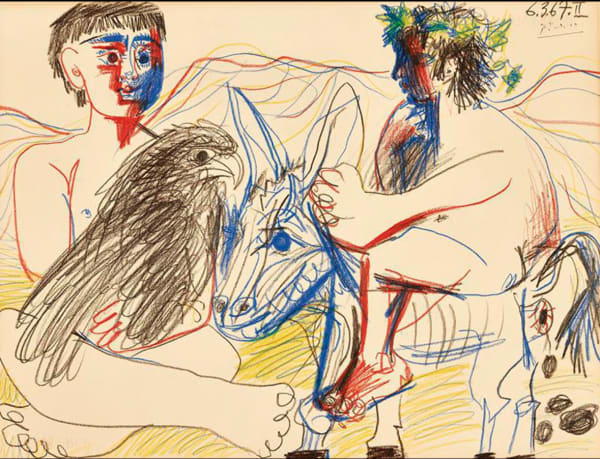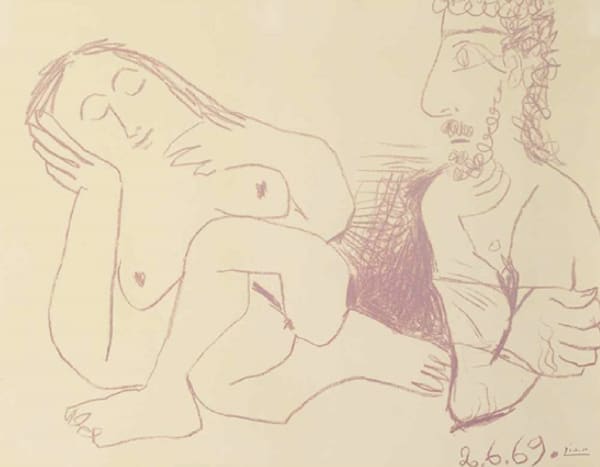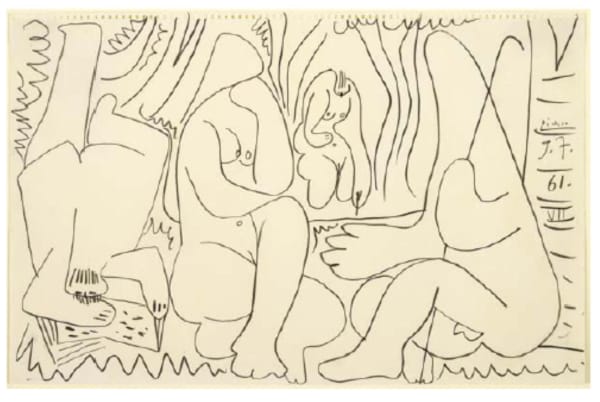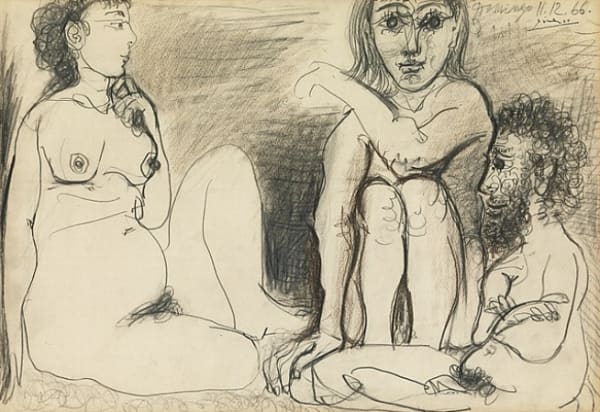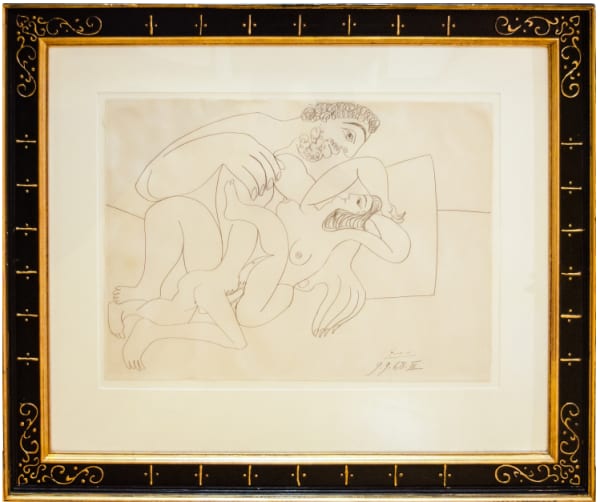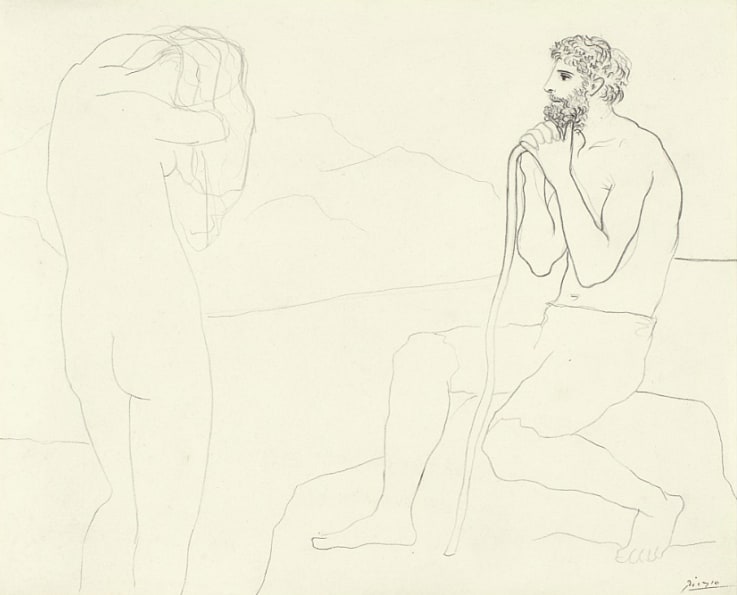
Pablo Picasso
22.9 x 27.9 cm
Pablo Picasso’s Homme et Femme, 1926, a pencil drawing on paper measuring 9 x 11 inches (22.9 x 27.9 cm). It belongs to a body of work where Picasso explored intimacy, mythology, and the timeless dialogue between man and woman, rendered with the deceptive simplicity of his masterful line.
The composition depicts two figures in a sparse landscape. On the left, a nude woman stands, turned away from the viewer, her hands raised to her head as she arranges or loosens her hair. Opposite her, a bearded man sits on a rock, leaning slightly forward while clasping a long staff with both hands. His gaze is directed toward the woman, creating a charged space of contemplation and desire between them.
Picasso employs an economy of line, using the bare minimum of marks to define form and space. The contours of the woman’s back, the curve of her leg, and the slight tilt of the man’s head all emerge with clarity and grace. The mountain-like forms sketched in the background situate the figures in nature, further reinforcing their timeless, archetypal quality.
This drawing exemplifies Picasso’s extraordinary draftsmanship—his ability to capture gesture, emotion, and narrative with a few precise lines. Pencil on paper gives the work an intimacy and immediacy, as though it were drawn in a single, unbroken moment of inspiration. The spareness of the medium allows the viewer to focus entirely on the psychological tension and spatial relationship between the figures.
Picasso’s line is confident yet fluid, alternating between fine delicacy and firmer accents, particularly in the man’s beard and profile. This balance of restraint and expressive emphasis demonstrates why Picasso is often regarded as one of the greatest draughtsmen of the 20th century.
Homme et Femme reflects Picasso’s ongoing fascination with the dynamics of male and female presence. The work suggests not only physical contrast—strength and softness, clothed and nude—but also psychological dialogue: the woman’s self-contained gesture contrasts with the man’s direct, contemplative gaze.
The composition has echoes of mythological archetypes, recalling scenes of shepherds, nymphs, or rustic lovers drawn from classical antiquity. Yet Picasso distills these themes into a modern simplicity, stripping away detail until only the essential remains: the eternal interplay of masculine and feminine.
Homme et Femme (1926) is a pencil drawing on paper by Pablo Picasso, measuring 9 x 11 inches (22.9 x 27.9 cm). The work depicts a nude woman standing with her back to the viewer and a bearded man seated with a staff, set against a sparse natural backdrop. Executed with a masterful economy of line, the drawing exemplifies Picasso’s ability to convey profound psychological tension and timeless themes through simplicity, balance, and precision.
For more information or to buy Homme et Femme, 1926 by Pablo Picasso, contact our galleries using the form below.-
 Pablo PicassoThe Foot Bath | Le Bain de pieds, 1960
Pablo PicassoThe Foot Bath | Le Bain de pieds, 1960 -
 Pablo PicassoFemme tenant un journal, 1915
Pablo PicassoFemme tenant un journal, 1915 -
 Pablo PicassoTrois Personnages,, 1954
Pablo PicassoTrois Personnages,, 1954 -
 Pablo PicassoQuatre têtes d’élégantes (Four Elegant Heads), c. 1899
Pablo PicassoQuatre têtes d’élégantes (Four Elegant Heads), c. 1899 -
 Pablo PicassoLes déjeuners,, 1961
Pablo PicassoLes déjeuners,, 1961 -
 Pablo PicassoTête de faune, 1958
Pablo PicassoTête de faune, 1958 -
 Pablo PicassoTeenager, eagle and donkey, 1967
Pablo PicassoTeenager, eagle and donkey, 1967 -
 Pablo PicassoTrois hommes et femme nus, 1967
Pablo PicassoTrois hommes et femme nus, 1967 -
 Pablo PicassoHomme Assis, 1971
Pablo PicassoHomme Assis, 1971 -
 Pablo PicassoBust of Naked Man and Woman, 1969
Pablo PicassoBust of Naked Man and Woman, 1969 -
 Pablo PicassoLe déjeuner, 1962
Pablo PicassoLe déjeuner, 1962 -
 Pablo PicassoLes déjeuners,, 1961
Pablo PicassoLes déjeuners,, 1961 -
 Pablo Picasso·Toros, 1961
Pablo Picasso·Toros, 1961 -
 Pablo Picasso·Étude pour la Suite Des Déjeuners III, 1959
Pablo Picasso·Étude pour la Suite Des Déjeuners III, 1959 -
 Pablo PicassoLes Dejeuners, 1961
Pablo PicassoLes Dejeuners, 1961 -
 Pablo PicassoTrois Personnages nus Assis, 1966
Pablo PicassoTrois Personnages nus Assis, 1966 -
 Pablo PicassoL’Etreinte, 1968
Pablo PicassoL’Etreinte, 1968
Join our mailing list
* denotes required fields
We will process the personal data you have supplied in accordance with our privacy policy (available on request). You can unsubscribe or change your preferences at any time by clicking the link in our emails.
This website uses cookies
This site uses cookies to help make it more useful to you. Find out more about cookies.






